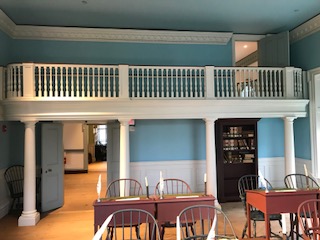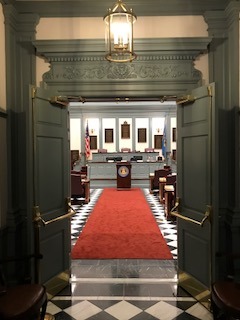His Master's Voice
- Nate and Lori
- Jul 11, 2018
- 10 min read

"Life is one grand sweet song, so start the music"
Ronald Reagan
State 38: Delaware - May 16, 2018
Nate
We woke up at a Walmart in Georgetown, DE well rested, and ready for a brand new day. Yesterday, we visited a lighthouse ship, and we could not wait to see what adventures lie ahead! The first task of the day was to drive 36 miles North to Dover for the Cross Country Couple's "Historic Location" for Delaware; The Old Statehouse. I have been looking forward to visiting this building for a long time, because of a very historic event which once occurred here! On December 7, 1787, Delaware became the first of the 13 colonies to ratify the US Constitution by a unanimous vote immortalizing Delaware as “The First State”.

Delaware’s capitol complex is in a National Historic District called First State Heritage Park consisting of 79 restored historic brick buildings from the 18th and 19th century situated around a sprawling green. The brick sidewalks were a welcome change from the poured concrete of typical capitol complexes, and the area felt more like a college campus than the head of the state government. Typically, people only venture to statehouses on official capacity, but during our visit we saw everyday people jogging, walking their dogs, picnicking, and enjoying the day! Delaware had successfully transformed their capitol complex into a destination! I would come hang out at First State Heritage Park if Delaware ends up being my new home!
Situated at the far end of the green, the Old Statehouse served as Delaware’s capitol building from 1779 until 1933 when the government moved to the newly constructed Legislative Hall. After the state's government vacated, the Old State House, fell into disrepair in the decades to come. In 1976, the building was restored to its original 18th century appearance in celebration of America’s Bicentennial. For over 224 years, the Old State House has served as a focal point and heirloom to the residents of the “First State”. If you are ready, let's go explore this national treasure together!
The Old State House is a 2 story red brick building constructed in traditional Georgian architecture; a style popular in 18th century Great Britain. The perimeter of the roof is surrounded by a banister, and perched in the center is a copula once serving as a bell tower. I love the look of aged brick buildings! As we approached the main entrance, a historical marker caught my eye which read “On July 29, 1776, the Declaration of Independence was read from this porch for the first time to the people of Dover". I can only imagine what it must have been like standing in this very spot on that a historic day! Please see the pictures below.
The Old Statehouse’s grand external staircase was not all that grand. Considering the staircase was built over two centuries ago during the Revolutionary War, the fact that it still exists is nothing short of miraculous! Upon ascending the meager staircase predating our nation's sovereignty, we entered the Old Statehouse of America’s first state! I am so excited!!! As soon as we crossed the threshold, we were greeted by a security guard dressed as an American Revolutionary War Soldier, armed with a musket who proceeded to illegally search us. I am just kidding, but how funny would that have been? LMAO!!! From quarter sawed wood plank flooring to the thick textured plastered wall, as soon as you enter the Old Statehouse you are immediately thrusted back into America's Colonial Period.
The first floor of the Old Statehouse is dominated by an 18th century courtroom, with smaller rooms flanking either side. The most commanding architectural feature on the first floor was a dramatic and curvaceous duel staircase leading to the former home of the state's legislature on the second floor. What Delaware lacked in their external staircase, they certainly made up for in their internal one. This is the grandest of all grand internal staircases I have encountered on my cross country trip! Please see the pictures below.
Upon ascending the staircase leading to the second floor, we arrived in a wide open room with historical displays, and the bell from 1763 which once ding donged high above the old state house. Please see the pictures below.
To the left was the Old Senate Chamber, and to the right was the Old House Chamber. Overlooking each chamber was a public viewing balcony accessible via another staircase. Please see the pictures below.

Delaware did a phenomenal job on the restoration of the Old State House. Even the modern amenities such as HVAC, fire suppression systems, and an elevator for ADA compliance were well camouflaged within the building's 18th century appearance. The most accurate representation of the restoration was the barely 6 foot tall doorways between the rooms! I smacked my 6.0’ noggin at least three times during my visit. OUCHY!!! It is true, people were a lot shorter back in the day. This is not the first time I smacked my head on an old low clearance doorway, which you can read more about by clicking here. Delaware makes a point to preserve its rich patriotic colonial history, and the Old Capitol Building is the state's crown jewel! What an amazing American experience! Please see additional pictures below of our visit to the Old Statehouse of the first state.
After departing Delaware's Old Statehouse, we walked to the opposite side of the First State Heritage Green to visit the current home of Delaware’s government; Legislative Hall. Constructed in 1933 in Colonial Revival architecture, Legislative Hall is the current home to the Governor and General Assembly of Delaware. While standing outside of Legislative Hall, I noticed the most striking external feature of the building was its similarity in design to the Old State House. From the two story brick construction, the perimeter of the roof is surrounded by a banister, and complete with a copula in the center, it appears as if the Legislative Hall was Old State House’s big brother, or perhaps the Old State House is the Legislative Hall’s mini me! Nevertheless, the design of the two statehouses complimented each other exceptionally well considering they were constructed over 150 years apart! Please see the pictures below.
Similar to the entrance of the Old State House, the grand external staircase of Legislative Hall turned out to be not so grand. Upon entering, we were searched by security at the door, discovered we had just missed the last guided tour for the day, and there were no self guided booklets available. I was really looking forward to touring Delaware’s Legislative Hall! Without guide nor self-guided booklet, I wandered aimlessly around the statehouse unsure of the significance of what I was seeing. Please see the pictures below of our visit to Delaware's Legislative Hall.
Eventually, I made my way into the House and Senate Chambers, and both possessed a noticeable colonial ambiance! For example, the light blue and white walls are identical to the interior color scheme in the Old Statehouse. Please see the pictures below of Delaware's Legislative Chambers.
HOUSE
SENATE

After departing Delaware's Legislative Hall, we drove across First State Heritage Park to the Johnson Victrola Museum to learn about the Cross Country Couple's “Famous Person” for Delaware, Eldridge Johnson. Born in Wilmington, Delaware on February 6, 1867, Eldridge Johnson was an engineer, inventor, businessman, innovator, philanthropist, and pioneer in the recording industry. Johnson founded the Victor Talking Machine Company, and built it into the leading producer of phonographs and phonograph records in the world. Johnson's influence in the field of recording was so significant, he was posthumously awarded the 1984 Grammy Trustee Award. Before talking more about Eldridge Johnson, we must first briefly discuss the history of recorded sound.

Patented on March 25, 1857, Frenchman Eduard-Leon Scott De Martinville invented the earliest known device for recording sound called the Phonautograph. The Phonautograph transcribed sound waves into lines on paper, and was developed as a laboratory instrument to study acoustics. Although audio playback of the paper recording called phonautograms was impossible in Scott’s time, these squiggles on paper possessed enough information about the recorded sound to one day recreate it. In 2008, scientists from Lawrence Berkley National Library, successfully converted a phonautogram recorded by Scott on April 9, 1860 of the French folk song “Au clair de la lune” into a playable digital audio file. Presumed to be in Scott’s own voice, the 20 second one-line excerpt of the song represents the earliest recognizable record of the human voice, and the earliest recognizable record of music! Please click here to listen to Scott’s recording.

While other inventors such as Scott had produced devices that could record sounds, Thomas Edison was the first person to both record sound, and reproduce the recorded sound. On August 12, 1877, Edison unveiled his working model of the Phonograph, and the first recording and reproduction of sound was the children's nursery rhyme “Mary Had a Little Lamb”. Edison has stated of all of his inventions, the phonograph was by far his favorite. First, you spoke into a large cone connected to a cylinder wrapped in tin foil while turning a hand crank. Inside the phonograph was a needle, and the sound of your voice would vibrate the needle making grooves on the tin foil. A different needle read the indentations on the foil to play back the recorded message with a turn of the handle. Since foil was flimsy, Edison discovered cylinders covered in wax was a more durable option. Humans had achieved the ability to record and replay sound! Please click here to listen to Edison's recording of "Mary Had a Little Lamb".

German-born American inventor, Emile Berliner founded the United StatesGramophone Company in 1894 which would revolutionize recorded sound! While Edison's phonographs played music off a wax cylinder, Berliner’s gramophone played music off flat round discs, which the world would come to know as records. The turntable of a gramophone ran via continuous hand cranking making it impossible to maintain the appropriate speed necessary to play the record. In 1894, a man named Henry Whitaker brought his gramophone into a machine shop owned by Eldridge Johnson, and asked him to build a spring driven motor for the gramophone. Berliner’s disc playing gramophone required a strong motor spinning at a constant speed to overcome the drag of the needle on the record. Johnson successfully developed a spring powered motor for the gramophone, and a triple ball based centrifugal governor to maintain a constant rate of speed.
In 1895, Emile Berliner learned about Johnson's innovation to the gramophone, and hired Johnson to produce motors and speed regulators for his machines. Meanwhile, Johnson began secretly experimenting with ways to mass produce disc records. After examining Berliner’s records under a microscope, Johnson discovered the records had random jagged grooves creating a scratching during playback! Over the next two years, Johnson developed a way to mass produce records with less erroneous noise, and went into business for himself. Berliner sued for copyright infringement, but a judge ruled in Johnson's favor.
By 1901, Johnson had possession of Berliner's patents for the record playing phonograph, and founded the Victor Talking Machine Company. Over the next 30 years, Johnson’s Company grew to encompass 10 city blocks in Camden, New Jersey, had sales offices located throughout the world, produced records for the most famous recording artists of the time, and sold millons of phonographs and tens of millons of records. Johnson retired in 1927, and the The Victor Talking Machine Company was sold to RCA in 1929.
Opened to the public on December 14, 1967, The Johnson Victrola Museum interprets the life and achievements of Eldridge Johnson; founder of The Victor Talking Machine Company. The museum’s exhibits include; trademarks, recordings, memorabilia, relics, paintings, Nipper collection, and advertisements telling the story of Johnson’s life, his company and his contributions to the sound-recording industry.

The highlight of the museum is the widest variety of Victrola’s you will find anywhere, and many still play music! The earliest phonographs had external horns, but back in the day people found them ugly. As a result, the horn of the phonographs were enclosed within a wooden case resembling a piece of furniture. Today, the external horn phonographs are among the most sought after by collectors for their rarity and beauty. I once owned a Victor III external horn phonograph in perfect working order, but painfully I had to sell it prior to departing on my cross country trip. Pictured above is the example of the Victor III present at the museum! Please see the pictures below of the Victor external horn phonographs.
Below are pictures of various Victor internal horn phonographs, and my tour guide Jackie graciously played a few records for me, which you can listen to by clicking here, here, and here.

There are a few key factors which contributed to the success of Johnson’s company. Johnson always strived to improve upon his product evident by the vast number in finishes, styles, sizes and models manufactured. In addition, Johnson had the most prestigious musicians of the day record for Victor with exclusive contracts. Arguably, Johnson's most successful acquisition was Nipper. Nipper was a fox/bull terrier who lived in England, enjoyed chasing rats, nipping at the backs of people's ankles, and listening to music. Nipper’s owner was an English Artist named Francis Barraud. One day in 1899, Barraud saw Nipper intently listening to a phonograph, and created his most famous painting "His Master's Voice". The painting and copyright were purchased by Berliner’s Gramophone Company, and Johnson acquired the U.S. rights to the painting in 1901. Johnson, branded Nipper on everything from watches to salt and pepper shakers. The iconic image of Nipper looking into a phonograph became the international logo for The Victor Talking Machine Company, and one of the earliest and most successful trademarks of all time. Please see the picture below of Nipper related Victor merchandising including a 6' tall Nipper!
Please see additional pictures below of our visit to the Johnson Victrola Museum.
Why should we care about an obsolete antique relic such as the phonograph? If for no other reason, the origins of mass produced music began with the phonograph! Don’t believe me? Ok let’s take a trit trot down memory lane. Today people typically listen to music via: Smartphone, MP3, Ipod, Srius XM, live streaming, and car radio. Prior to today's popular methods, there was: cd player (1990’s), Walkman(1980’s), 8 track (1970’s), record player (1950’s), console radio (1920’s), and handcrank disc phonograph(1900’s)!
After consulting with Ancestry.com, the phonograph is the Great Great Great Great Grandfather of your preferred modern method of listening to music. Had it not been for visionaries such as Eldridge Johnson who revolutionized the manner in which music was recorded and played, the music we enjoy and the manner in which we enjoy it, would not exist today! If you have never had the opportunity to hear a phonograph play a record in person, you should make a point to stop by the Johnson Victrola Museum in Dover. There is just something simple, elegant, timeless, and romantic and about listening to music from a phonograph!
After departing the Johnson Victrola Museum, we drove across town where we found a Walmart to spend the night.


























































































































Comments